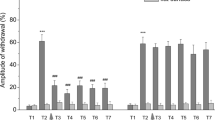Conclusions
-
1.
During a combination of food stimulation with electrical stimulation inHelix lucorum for 5–15 combinations a defensive reflex showing all the properties of a conditioned reflex is formed.
-
2.
Between 40 and 60 min after formation of the conditioned reflex a spike response appears in command neurons of defensive behavior in response to the conditioned stimulus, and lasts throughout the experiment. The response to the food stimulus in command neurons of food behavior is very slightly reduced.
-
3.
The changes taking place are the result of plastic changes in sensory cells of the defensive reflex arc.
Similar content being viewed by others
Literature cited
É. A. Asratyan, in: Philosophical Problems in the Physiology of Higher Nervous Activity and Psychology [in Russian], Izd. AN SSSR, Moscow (1963), p. 299.
É. A. Asratyan, in: Outlines of the Physiology of Conditioned Reflexes [in Russian], Nauka, Moscow (1970), p. 150.
P. M. Balaban and E. G. Litvinov, Zh. Vyssh. Nerv. Deyat.,27, No. 3, 538 (1977).
E. G. Litvinov and P. M. Balaban, in: Structural and Functional Analysis of Brain Activity [in Russian], Nauka, Moscow (1973), p. 43.
E. G. Litvinov, P. M. Balaban, O. A. Maksimova, and B. P. Masinovskii, Zh. Vyssh. Nerv. Deyat.,26, No. 1, 203 (1976).
E. G. Litvinov and D. B. Logunov, in: Technical Problems in and Equipment for Experimental Neurophysiology [in Russian], Nauka, Moscow (1976).
O. A. Maksimova, Zh. Vyssh. Nerv. Deyat.,29, No. 4, 793 (1979).
O. A. Maksimova and P. M. Balaban, Zh. Vyssh. Nerv. Deyat.,29, No. 5, 978 (1979).
D. A. Sakharov, The Genealogy of Neurons [in Russian], Nauka, Moscow (1974).
P. M. Balaban, Acta Neurobiol. Exp.,39, No. 2, 97 (1979).
M. S. Berry and V. W. Pentreath, Exp. Biol.,65, No. 2, 361 (1976).
T. H. Bullock, in: Sensory Communication (ed. W. A. Rosenblith), MIT Press, Cambridge, Mass. (1961).
G. A. Cottrell and J. B. Macon, J. Physiol. (London),236, No. 2, 435 (1974).
W. J. Davis and R. Gillette, Science,199, 801 (1978).
W. J. Davis, G. I. Mpitsos, and J. M. Pinnec, J. Comp. Physiol.,90, No. 3, 207 (1974).
J. Diamond, in: Fish Physiology: Sensory Systems and Electric Organs, eds. W. S. Hoar and D. J. Randall, Vol. 5, No. 7, Academic Press, New York, (1971), p. 265.
G. A. Horridge, Interneurons, Freeman, San Francisco (1968).
E. R. Kandel, Cellular Basis of Behavior, Freeman, San Francisco (1976).
I. Kupfermann and K. R. Weiss, Behav. Brain Sci.,1, 3 (1968).
G. I. Mpitsos, S. D. Collins and S. D. McClelland, Science,199, 801 (1978).
J. Salanki and Van Bay Truong, Ann. Biol. (Tihany),42, 115 (1975).
M. J. Wells, in: Simple Nervous Systems, eds. P. N. R. Usherwood and D. R. Newth, London (1975).
M. J. Wells and J. Wells, Anim. Behav.,19, 305 (1971).
C. A. G. Wiersma and K. Ikeda, Comp. Biochem. Physiol.,12, 509 (1964).
J. L. Young, Proc. R. Soc London, B,163. 285 (1965).
Author information
Authors and Affiliations
Additional information
Translated from Zhurnal Vysshei Nervnoi Deyatel'nosti, imeni I. P. Pavlova, Vol. 30, No. 5, pp. 1003–1011, September–October, 1980.
Rights and permissions
About this article
Cite this article
Maksimova, O.A. Defensive conditioning inHelix lucorum and associated changes in command neuron activity. Neurosci Behav Physiol 13, 209–215 (1983). https://doi.org/10.1007/BF01148852
Received:
Issue Date:
DOI: https://doi.org/10.1007/BF01148852



